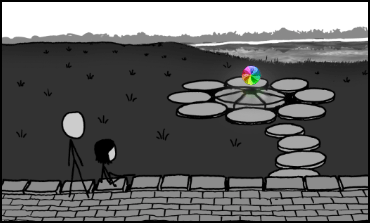Today’s post was written by my husband, Mark. He has long been a fan of Steve Jobs and I think working out here in Silicon Valley only increased Mark’s appreciation for him and sadness at his passing. I invited Mark to compose his thoughts and publish them here.
Technology is quite nearly always beautiful to those engineers who design it. It’s a fundamental trait of a good designer, I think. It’s the same trait that lets a biologist find unspeakable beauty in a slime mold; the same trait that made my heart skip a beat when my autonomous battery monitor powered itself up and took its first measurements on its own, without my help.
From ENIAC and UNIVAC onwards, few saw the technology of the past century as beautiful, those precious engineers excepted.
Now, Steve Jobs was not an inventor.
Steve Jobs did not design the first graphical user interface, that was Xerox PARC. Steve Jobs did not come up with the first internet-ready smartphone, Palm beat him by six years. There were personal computers before the Apple II, there were MP3 players before the iPod, and there were tablet computers before the iPad.
Steve Jobs was an innovator. He made technology beautiful to the world.
During my commute home that Wednesday evening, I stopped on a hill crest to see the sun pass below the Santa Cruz mountains, with all of Silicon Valley bathed a rusty orange. And I came to realize to a greater extent the impact Steve Jobs had on this giant community by the Bay. I probably would not be overstating the case to claim that his innovations are a large part of what has allowed the Valley to survive the most recent recession and technology to continue to progress.
You see, I work in an industry that, five years ago, would not have been considered even remotely related to Apple. I design chips for cellular phones and other mobile devices. Not so long ago, smartphones were tools for the busy executive on the go, and the rest of the world just wanted cheaper, easier cell phones with longer battery life. But selling to a market that wants little more than “cheaper” is not the way to grow an industry. After all, we thought that the Motorola RAZR was one of the biggest innovations in the field.
It wasn’t.
The release of the iPhone changed our industry in a way we could never have imagined. It gave us new goals, new customers, and more importantly, a new vision. The subsequent transformation of the smartphone from a corporate e-mail checking device to an information age conduit usable by anyone rearranged the Valley as much as the commercialization of the internet.
And use it they did. We have all seen what smartphones turned into, but the important point is that you didn’t need to have purchased an iPhone to have been a part of the revolution. iPhone lookalikes and imitators quickly hit the market, but all of these devices fell far short of Jobs’s vision. It was not long, though, before real competition began to appear, and the smartphone shelves at your local stores are now filled with devices which stand solidly on their own merits, yet owe a debt of gratitude to their sleek, silver, and famously rounded-rectangular inspiration and spiritual ancestor.
The impact extended beyond cellular phones themselves, of course. The new titans—Facebook, Twitter, and the like—thrive because people can write a note, check in on a friend, or talk to the world without having to open a laptop, first. Even during the scary months that followed the credit crunch in 2008, empty office space in cities like Palo Alto would quickly be gobbled up by fledgling businesses developing a new product: the App. More importantly, no longer did a developer need to be anywhere near his customers, or even Apple for that matter. All that was needed was the right mix of innovation, gumption, and creativity.
Of course, Steve Jobs has left his marks on plenty of other industries. The success of iTunes and the iPod changed the way the music industry approached digital music, and, more importantly, opened the door to thousands of independent musicians not under the thumb of the major labels. The original Macintosh graphical user interface made the personal computer more than a skillful spreadsheet manipulator; its long-delayed successor, Mac OS X, challenged the supposedly unshakable Microsoft and spurred new progress in the doldrums-bound field of operating system design.
I guess what I am trying to say is… you don’t need to have ever owned a product with the Apple logo to have been touched by Steve Jobs’s trademark innovation. If you’ve ever Tweeted on the go, asked your phone where you should eat for dinner, used a laptop while reclining at home, gone for a jog with your digital tunes, snapped a picture of the kids in the car and posted it on the internet for the grandparents to see, or even simply double clicked on an icon, you’ve been a part of it.
For my part, I reflected on all of this while listening to a playlist I put together some time ago about the beauty of engineering that I’ve happened find in the world. On the playlist are songs such as “Pure Imagination” from Charlie and the Chocolate Factory, “Henry Ford” from Ragtime, “Radical Dreamers” by Yasunori Mitsuda, “In Search of Diamonds” by Eric Fullerton, “The World Is Just Awesome” from the Discovery Channel, and “Weird Science” by Oingo Boingo. It ends, appropriately, with the Finale and Engineer’s Song from Titanic, the Musical.
I don’t own an iPod or iPhone myself. Rather, I’ll be listening to these songs on my HTC Hero, a wonderful little Android phone that nonetheless owes its existence through and through to the vision of Steve Jobs.
And you know what?
It is beautiful.

